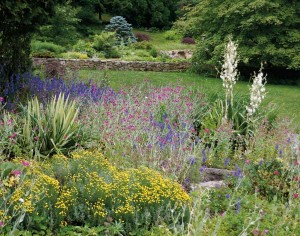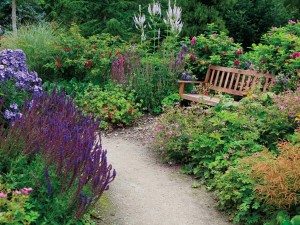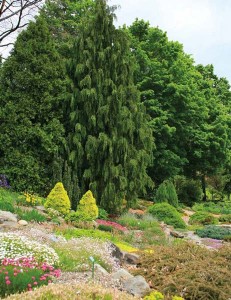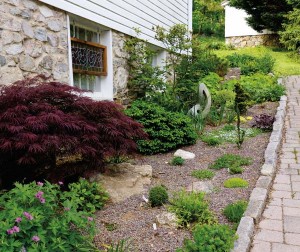Now and again, gardeners are captivated by a colorful perennial or attractive shrub they see in public gardens or on the pages of glossy catalogs. Disappointment sets in when the plant doesn’t do well. The issue isn’t whether a person has a “green thumb” or not. More than likely the problem stems from failing to take the time to evaluate the conditions at the planting site and selecting plants that will thrive there.
What follows are some things to consider when you’re making plans for your landscape this spring:
1Evaluate
Some questions to ask include: Is the site in full-sun or part-shade? Morning or afternoon shade? Is the area well-drained, or does it remain soggy after rains? How exposed is it to winds? Does the sun bake the location in August? Will the plantings be next to paved areas that are salted in the winter?
2Research
One need not have a home horticultural library to research the appropriate ornamentals for specific conditions. Just discuss your site with the knowledgeable folks at your local fine nursery (“What do you recommend for some color in a part-shade, poorly drained area?”), or do a search on authoritative websites like that of the Missouri Botanic Garden (missouribotanicalgarden.org), or the native-plant-finder link on Mt. Cuba Center’s site (mtcubacenter.org).
When you see a plant that catches your eye, take a picture (it’s so easy with today’s cell phones) and ask your more-experienced gardening friend or nursery person to identify it. From there, you’ll be able to determine if it will thrive in your location.
3Time Commitment
How much time a gardener is willing to spend on weekly maintenance needs to be considered in advance so that the garden doesn’t become an objectionable chore. Low-maintenance perennials, shrubs and ground-covering plants are widely available for those who want an inviting display that doesn’t require continuous attention.
4Drainage
This is very important. More plants are lost over the winter because of poor drainage rather than low temperatures. Perhaps you have clay soil, a major challenge for growing ornamentals (an upcoming column will offer some advice), or have sandy or thin soil that would benefit from improvement. A soil analysis might be in order.
 5Plant in Communities
5Plant in Communities
Whether you favor native plants or newly introduced hybrids, aim for lots of color or ample foliage. No matter your preference, always amass your plants in communities that prefer similar conditions. For instance, cone flower, coreopsis, lamb’s ears, lavender, day lilies and sedums prefer hot, dry spots with good drainage. Species like ligularia, rodgersia, blue iris (Iris versicolor), yellow iris (Iris pseudacorus), winterberry holly (Ilex verticillata) and river birch (Betula nigra) will tolerate boggy spots.
Dry shade requires careful planning. It’s also practical to group your selections that will not tolerate dry spells where the watering hose will be handy.
6 Rethink Established Gardens
Even long-established gardens benefit from a fresh look from time to time. If something isn’t performing well, has been too aggressive or is obstructing the view, just get rid of it! It’s OK to cut back or rip out that overgrown yew. Or, perhaps a maturing tree has shaded the sun-loving plants, and they need to be moved and replaced.
7Avoid Monoculture
If you want to create a visual screen around your yard, it is not a good plan to put in a row of the same species. Why? Sometimes a new pest or disease comes along that is very specific: Remember the loss of elms (Ulmus) decades ago? The present concerns are with loss of ash (Fraxinus) trees and hemlocks (Tsuga) that are succumbing to the woolly adelgid insect. Instead, consider a mixed planting of several different species of needled- and broad-leaved evergreens along with some viburnums to provide spring flowers and fall-foliage color.
8Plan for Future Generations
Keep in mind that global climate change is a reality, and many trees that originate in colder climates will no longer be long-lived. Consider incense cedar (Calocedrus) or Atlas cedars (Cedrus) rather than spruces (Picea) and firs (Abies). And, why are more oaks (Quercus) not being planted? On a positive note, we can now grow crepe myrtles (Lagerstroemia) and even some selections of camellias.
9Access and Seating
If you are designing a new garden, lay out your paths carefully and be especially mindful of providing access to your borders for weeding without the need to walk over plantings. This can be done with island beds or by keeping borders only the depth that one can reach. Also be sure to provide comfortable garden seats in a shady spot where you can sit and take pleasure in your display.
 10Pollinators and Birds
10Pollinators and Birds
Birds and bees are vital to pollination. Consider choosing pollinator-friendly plants for your gardens.
11Fragrance
Enjoy the fragrance of lavender, phlox, dianthus or mints along the path you regularly take and, in particular, near entrances.
12 Raised Beds and Containers
If the soil quality or drainage situation is hopeless, consider establishing raised beds or growing perennials and small shrubs in containers. These will need frequent watering.
13All-season Interest
Keep in mind the importance of structural plants. I propose that when you see a garden that really appeals to you, it is likely one with strong structure through the seasons and includes dwarf conifers, boxwoods and evergreen hollies. Berried shrubs provide fall and winter color.
 14Gardening Journal
14Gardening Journal
Make notes through the weeks of the growing season, recording which plants did well and those that struggled. The journal will indicate the plants and flowers you particularly enjoyed and remind you of areas that need some fillers.
15 Buy Local
It’s always a good idea to purchase plants from local growers; it’s likely they have been grown in conditions similar to those in your garden.






SHARE
PRINT